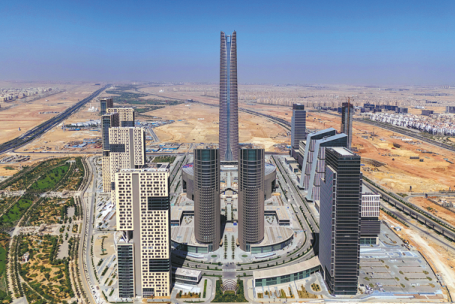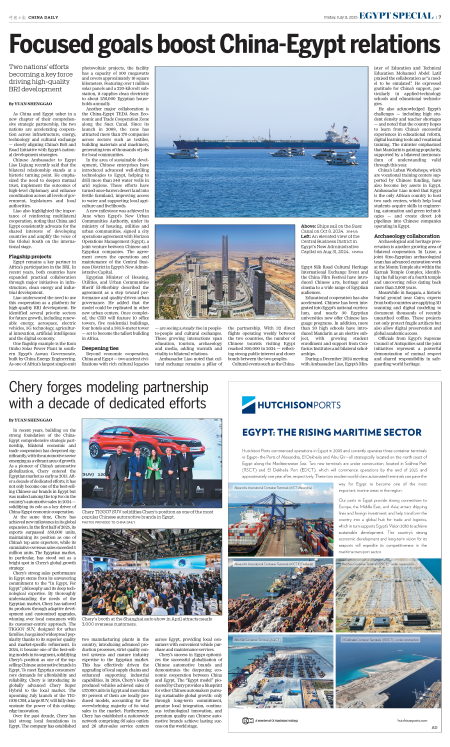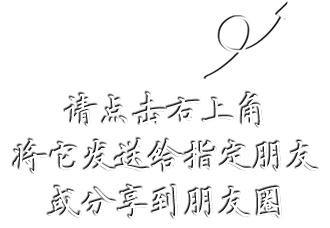
Ships sail on the Suez Canal on Oct 8, 2024.

An elevated view of the Central Business District in Egypt's New Administrative Capital on Aug 31, 2024.
As China and Egypt usher in a new chapter of their comprehensive strategic partnership, the two nations are accelerating cooperation across infrastructure, energy, technology and cultural exchange — closely aligning China's Belt and Road Initiative with Egypt's national development strategies.
Chinese Ambassador to Egypt Liao Liqiang recently said that the bilateral relationship stands at a historic turning point. He emphasized the need to deepen mutual trust, implement the outcomes of high-level diplomacy and enhance coordination across all levels of government, legislatures and local authorities.
Liao also highlighted the importance of reinforcing multilateral cooperation, noting that China and Egypt consistently advocate for the shared interests of developing countries and amplify the voice of the Global South on the international stage.
Flagship projects
Egypt remains a key partner in Africa's participation in the BRI. In recent years, both countries have expanded practical collaboration through major initiatives in infrastructure, clean energy and industrial development.
Liao underscored the need to use this cooperation as a platform for high-quality BRI development. He identified several priority sectors for future growth, including renewable energy, aerospace, electric vehicles, 5G technology, agricultural innovation, artificial intelligence and the digital economy.
One flagship example is the Kom Ombo Solar Power Plant in southern Egypt's Aswan Governorate, built by China Energy Engineering. As one of Africa's largest single-unit photovoltaic projects, the facility has a capacity of 500 megawatts and covers approximately 10 square kilometers. Featuring over 1 million solar panels and a 220-kilovolt substation, it supplies clean electricity to about 256,000 Egyptian households annually.
Another major collaboration is the China-Egypt TEDA Suez Economic and Trade Cooperation Zone along the Suez Canal. Since its launch in 2008, the zone has attracted more than 170 companies across sectors such as textiles, building materials and machinery, generating tens of thousands of jobs for local communities.
In the area of sustainable development, Chinese enterprises have introduced advanced well-drilling technologies to Egypt, helping to drill more than 540 water wells in arid regions. These efforts have turned once-barren desert land into fertile farmland, improving access to water and supporting local agriculture and livelihoods.
A new milestone was achieved in June when Egypt's New Urban Communities Authority, under its ministry of housing, utilities and urban communities, signed a city operations agreement with Horizon Operations Management (Egypt), a joint venture between Chinese and Egyptian companies. The agreement covers the operations and maintenance of the Central Business District in Egypt's New Administrative Capital.
Egyptian Minister of Housing, Utilities, and Urban Communities Sherif El-Sherbiny described the agreement as a step toward performance and quality-driven urban governance. He added that the model could be replicated in other new urban centers. Once completed, the CBD will feature 10 office towers, five residential buildings, four hotels and a 385.8-meter tower — set to become the tallest building in Africa.
Deepening ties
Beyond economic cooperation, China and Egypt — two ancient civilizations with rich cultural legacies — are seeing a steady rise in people-to-people and cultural exchanges. These growing interactions span education, tourism, archaeology and media, adding warmth and vitality to bilateral relations.
Ambassador Liao noted that cultural exchange remains a pillar of the partnership. With 32 direct flights operating weekly between the two countries, the number of Chinese tourists visiting Egypt reached 300,000 in 2024 — reflecting strong public interest and closer bonds between the two peoples.
Cultural events such as the China-Egypt Silk Road Cultural Heritage International Exchange Event and the China Film Festival have introduced Chinese arts, heritage and cinema to a wide range of Egyptian audiences.
Educational cooperation has also accelerated. Chinese has been integrated into Egypt's national curriculum, and nearly 30 Egyptian universities now offer Chinese language programs. In addition, more than 20 high schools have introduced Mandarin as an elective subject, with growing student enrollment and support from Confucius Institutes and bilateral scholarships.
During a December 2024 meeting with Ambassador Liao, Egypt's Minister of Education and Technical Education Mohamed Abdel Latif praised the collaboration as "a model to be emulated". He expressed gratitude for China's support, particularly in applied-technology schools and educational technologies.
He also acknowledged Egypt's challenges — including high student density and teacher shortages — and noted that the country hopes to learn from China's successful experiences in educational reform, digital learning tools and vocational training. The minister emphasized that Mandarin is gaining popularity, supported by a bilateral memorandum of understanding valid through this year.
China's Luban Workshops, which are vocational training centers supported by Chinese funding, have also become key assets in Egypt. Ambassador Liao noted that Egypt is the only African country to host two such centers, which help local students acquire skills in engineering, automation and green technologies — and create direct job pipelines into Chinese companies operating in Egypt.
Archaeology collaboration
Archaeological and heritage preservation is another growing area of bilateral cooperation. In Luxor, a joint Sino-Egyptian archaeological team has advanced excavation work at the Montu Temple site within the Karnak Temple Complex, identifying the full layout of a fourth temple and uncovering relics dating back more than 3,000 years.
Meanwhile in Saqqara, a historic burial ground near Cairo, experts from both countries are applying 3D scanning and digital modeling to document thousands of recently unearthed coffins. These projects not only protect fragile artifacts but also allow digital preservation and global academic access.
Officials from Egypt's Supreme Council of Antiquities said the joint initiatives represent a powerful demonstration of mutual respect and shared responsibility in safeguarding world heritage.

